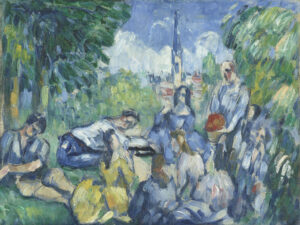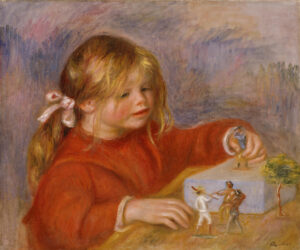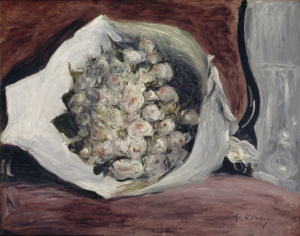Cézanne and Renoir: An Unprecedented Exhibition in Hong Kong
Paul Cézanne (1839-1906) and Pierre-Auguste Renoir (1841-1919) were not only the fathers of the Impressionist movement and two of the most influential figures in the art world, but they were also one of the greatest friendships in the history of art. The unprecedented exhibition Cézanne and Renoir: Looking at the World on view at HKMoA until 7 May is a rare opportunity to explore the artistic dialogue between the two masters, offering an innovative exploration of their deep friendship, emphasising not only their artistic dialogue but also their personal connection.
Featuring a collection of 52 masterpieces, the exhibition aims to illuminate how these masters interpreted the world around them at a time of significant societal change in France, while highlighting their enduring friendship, which blossomed during their time together in Paris in the 1860s.
Organised in collaboration with the Musée de l’Orangerie and the Musée d’Orsay, the exhibition is meticulously curated, juxtaposing the works of Cézanne and Renoir to highlight their differing perspectives on the world around them. While both artists were contemporaries and shared a mutual respect for one another, they approached their subjects with distinct styles and philosophies. Cézanne’s work is characterised by a methodical approach to form and colour, often focusing on landscapes and still life. In contrast, Renoir’s paintings shimmer with vibrant colour and a sense of immediacy, capturing the joy of life through portraits and scenes of leisure.
Visitors will be treated to an impressive selection of iconic works from both artists. Cézanne’s Mont Sainte-Victoire is a standout piece that encapsulates his revolutionary approach to landscape painting. The way he constructs the mountain with blocks of colour invites viewers to reconsider the very nature of perception. Similarly, Renoir’s Luncheon of the Boating Party offers a glimpse into the “joie de vivre” of the late 19th century, showcasing his ability to convey warmth and intimacy among friends.
These masterpieces not only embody the artists’ unique styles but also their philosophical explorations of reality, making them a focal point of the exhibition. The inclusion of lesser-known works alongside these iconic pieces provides a comprehensive view of their artistic journeys.
Understanding the historical context in which Cézanne and Renoir created their works is essential to appreciate their impact on future generations of artists. The exhibition delves into the late 19th-century art scene in France, a time of significant change and innovation. The Impressionist movement, which both artists were part of, revolutionised the way art was perceived, breaking away from traditional techniques and subject matters.
Cézanne’s influence on the development of Cubism and abstract art is particularly noteworthy. His method of breaking down objects into geometric forms laid the groundwork for future avant-garde movements. Renoir, on the other hand, inspired countless artists with his emphasis on light and colour, influencing the development of Post-Impressionism and beyond.
The exhibition encourages a dialogue between the viewer and the artwork, prompting questions about the nature of reality and the role of the artist in interpreting the world. The interplay of Cézanne’s structured compositions with Renoir’s fluid brushwork creates a dynamic viewing experience that lingers long after leaving the gallery.
One of the standout features of the exhibition is the use of simulated dialogues between Cézanne and Renoir, crafted to reflect the thoughts, feelings and artistic philosophies of both masters. This approach allows visitors to gain a deeper understanding of their mutual respect and differing views on art. By presenting their debates on colour, form and the role of an artist, the exhibition creates a dynamic atmosphere where visitors can appreciate the intellectual and emotional bonds that fueled their creativity.
The footprint map is another innovative tool used in the exhibition to trace the significant locations and moments in Cézanne and Renoir’s lives. This interactive map guides visitors through pivotal places in their friendship, such as art studios, cafés and the scenic landscapes of Provence. As attendees explore the map, they can access stories and anecdotes about their encounters, revealing how these experiences shaped their artistic practices and emphasising the impact of their friendship on their respective works.
One key anecdote recounts their first meeting at the studio of the artist Camille Pissarro, where they were introduced to each other’s work, highlighting how they were drawn together by their shared passion for art. The map also emphasises their plein air painting excursions in the countryside of Aix-en-Provence. Anecdotes about these outings reveal how they exchanged techniques and critiqued each other’s work, fostering an environment of collaboration and support.
By focusing on the personal and collaborative aspects of their relationship, the exhibition invites visitors to engage with the artists on a deeper level, fostering a greater appreciation for their contributions to art and the enduring nature of their bond. This innovative approach ensures that the exhibition is not just an art exhibition, but a rich narrative experience that celebrates friendship and creativity.
Whether you are an art aficionado or a casual observer, this exhibition offers a chance to engage with two of the most significant figures in art history. It invites contemplation of how their legacies continue to influence contemporary art and our understanding of the world around us.
Exhibition details here:
Cézanne and Renoir: Looking at the World – Masterpieces from the Musée de l’Orangerie and the Musée d’Orsay



